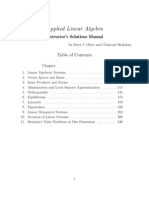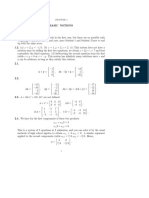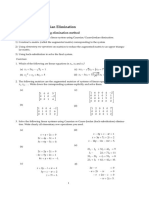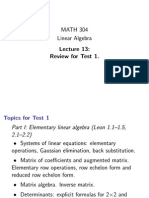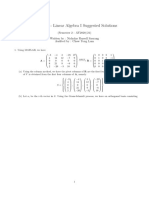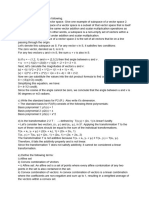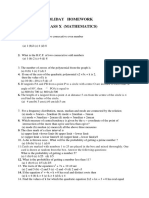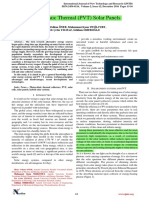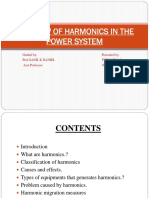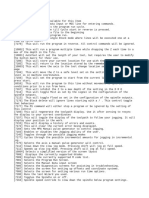Exercise 1.
Given the system of equations 8
< x + 3y + 2z = 1
2x + 4y + 5z = k 2
:
x + k 2 y + 3z = 2k
where k 2 R.
a) Study the system in terms of the values of k.
b) Find the solutions when k = 1, using the reduced row echelon form of the matrix.
c) For k = 0, …nd the inverse matrix of the principal minor 2 2, using Gauss-Jordan’s method.
Solution:
a) Let us consider the matrix form of the system, focusing on the augmented matrix:
0 1 0 1 0 1
1 3 2 1 1 3 2 1 1 3 2 1
@ 2 4 5 k 2 A !@ 0 2 1 k A !@ 0 2 1 k A
1 k2 3 2k F2 2F1 !F2 0 k 2 3 1 2k + 1 2F +(k2 3)F !F 0 0 k 2 3
1 k +k+2
3 2 3
F3 F1 !F3
From the last row, take
k2 1=0
then
k= 1
We obtain 4 cases:
- If k 6= 1 the system has only one solution (Rank of the matrix of the system 3, rank of the augmented
matrix 3).
- If k = 1 the system 0 1
1 3 2 1
@ 0 2 1 1 A
0 0 0 4
has no solution. (Rank of the matrix of the system 2, rank of the augmented matrix 3).
- If k = 1 the system 0 1
1 3 2 1
@ 0 2 1 1 A
0 0 0 0
has in…nite solutions. (Rank of the matrix of the system 2, rank of the augmented matrix 2).
b) When k = 1 the system we have obtained is
0 1
1 3 2 1
@ 0 2 1 1 A
0 0 0 0
but we are asked to obtain the reduced row echelon form, so we continue the process
0 1 0 1 0 7 5
1
1 3 2 1 2 0 7 5 1 0 2 2
@ 0 2 1 1 A !@ 0 2 1 1 A !@ 0 1 1 1 A
2 2
0 0 0 0 2F +3F !F
0 0 0 0 1
2 F1 !F1 0 0 0 0
1 2 1 1
2 F2 !F2
Finally, from the equivalent system we can write
z =
1 1
y = +
2 2
5 7
x =
2 2
1
�Exercise 2.
Given the matrices
1 1
A=
1 1
and B being a matrix 2 2 with all the elements di¤erent from zero and verifying B 2 = 7B + I (I is the
identity matrix), obtain:
a) Values a and b such that A2 = aA + bI.
b) Values p and q such that B 1 = pB + qI, checking that B has inverse matrix.
c) Values x and y for which B 3 = xB + yI.
Solution:
a)
A2 = aA + bI
2
1 1 1 1 1 0
= a +b
1 1 1 1 0 1
0 2 a+b a
=
2 0 a a+b
therefore
a = 2
a+b = 0
and
a = 2
b = 2
b) B veri…es the relation
B2 = 7B + I
then
B 2 + 7B = I
B (B + 7I) = I
1
Therefore B = B + 7I and the values we were asked for are
p = 1
q = 7
c)
B3 = B 2 B = ( 7B + I) B = 7B 2 + B = 7 ( 7B + I) + B =
= 49B 7I + B = 50B 7I
and the values are x = 50 and y = 7.
2
�Exercise 3.
Given the basis
B = f(1; 1) ; (2; 0)g
B0 = f(1; 2) ; (3; 4)g
a) Calculate the change matrices BC and CB 0 .
b) Use them to calculate BB 0 .
c) Find the coordinates of v 2 R2 respect to base B 0 if
1
vB =
1
Solution:
a)
1 2
BC =
1 0
1 3
0 1 3 1 3 2 2
BC = ! CB 0 = = 1
2 4 2 4 1 2
b) We know that
3 7
2 2 1 2 2 4
BB 0 = CB 0 BC = 1 = 3
1 2 1 0 2 2
c) Finally
7 15
2 4 1 2
vB 0 = BB 0 vB = 3 = 7
2 2 1 2
Exercise 4.
Let S and T be two subspaces de…ned as
S = (x; y; z) 2 R3 : x + y = 0
T = hf(2; 0; 1) ; (0; 1; 1) ; (4; 2; 4)gi
a) Calculate dim S, dim T and dim (T + S).
b) The sum S + T is direct?
Solution:
a)
S = (x; y; z) 2 R3 : x + y = 0 = (x; y; z) 2 R3 : y = x = f(x; x; z) : x; z 2 Rg = hf(1; 1; 0) ; (0; 0; 1)gi
dim S = 2
For T we need to check if the vectors are L.I. and since
2 0 1
0 1 1 =0
4 2 4
3
�vectors are L.D., but the two …rst vectors (for example) are L.I., then
T = hf(2; 0; 1) ; (0; 1; 1)gi
dim T = 2
Finally
T + S = hf(1; 1; 0) ; (0; 0; 1) ; (2; 0; 1) ; (0; 1; 1)gi
and we need to check how many vectors L.I. are there. As before, since the three …rst vectors verify that
1 1 0
0 0 1 = 2 6= 0
2 0 1
then
S + T = hf(1; 1; 0) ; (0; 0; 1) ; (2; 0; 1)gi
dim (S + T ) = 3
S + T = R3
b) Since
dim (S + T ) = dim S + dim T dim (S \ T )
3 = 2 + 2 dim (S \ T )
dim (S \ T ) = 1
and the sum is not direct (dimension should be 0 for the sum to be direct).
Exercise 5.
Let H = Im (f ) image subspace of f : R3 ! R3 given by
f (x; y; z) = (x + 2y; x + y + z; x + 2y + mz)
a) Calculate the dimension of H in terms of m.
b) If m is such that dim H is the lowest, calculate H ? and ker (f ).
Solution:
Im f = hff (1; 0; 0) ; f (0; 1; 0) ; f (0; 0; 1)gi = hf(1; 1; 1) ; (2; 1; 2) ; (0; 1; m)gi
Since
1 2 0
1 1 1 = m 4=0 !m= 4
1 2 m
then if m = 4, the vectors are L.D. and dim Im f = 2. If m 6= 4 then vectors are L.I. and dim Im f = 3.
b) Take m = 4 (so dim Im f = 2) and Im f = hf(1; 1; 1) ; (2; 1; 2)gi. Therefore
(1; 1; 1) (2; 1; 2) = (3; 4; 1)
and H ? = hf(3; 4; 1)gi.
Finally in order to calculate ker f let us equal function to 0:
(x + 2y; x + y + z; x + 2y 4z) = (0; 0; 0)
4
�then
x + 2y = 0
x+y+z = 0
x + 2y 4z = 0
and solving the system we get
x = 2
y =
z =
and then
ker f = hf( 2; 1; 1)gi
dim ker f = 1
Exercise 6.
a) Given S = hf( 1; 0; 1; 2) ; (1; 1; 1; 1)gi. Find the projection of v = ( 1; 0; 1; 0) onto S.
b) Using least-squares method …nd the straight line that …t best the points
( 1; 1) ; (0; 0) ; (1; 1) ; (2; 0)
a) Apply Gram-Schmidt
( 1; 0; 1; 2) 1p 1p 1p
u1 = = 6; 0; 6; 6
k( 1; 0; 1; 2)k 6 6 3
1p 1p 1p 1p 1p 1p
w2 = v2 (v2 u1 ) u1 = (1; 1; 1; 1) (1; 1; 1; 1) 6; 0; 6; 6 6; 0; 6; 6 =
6 6 3 6 6 3
1 1 2 4 2 1
= (1; 1; 1; 1) ; 0; ; = ; 1; ;
3 3 3 3 3 3
4 2 1
3 ; 1; 3; 3 2p p 1p p 1p p 1p p
u2 = 4 2 1 = 3 10; 3 10; 3 10; 3 10
3 ; 1; 3; 3
15 10 15 30
Projection:
1p 1p 1p 1p 1p 1p
projS ( 1; 0; 1; 0) = ( 1; 0; 1; 0) 6; 0; 6; 6 6; 0; 6; 6 +
6 6 3 6 6 3
p p p p p p p p !! p p p p p p p p !
2 3 10 3 10 3 10 3 10 2 3 10 3 10 3 10 3 10
+ ( 1; 0; 1; 0) ; ; ; ; ; ;
15 10 15 30 15 10 15 30
1 1 2 4 1 2 1 3 1 1 3
= ; 0; ; + ; ; ; = ; ; ;
3 3 3 15 5 15 15 5 5 5 5
b) We are searching for a straight line y = mx + n such that
1 = m+n
0 = 0m + n
1 = 1m + n
0 = 2m + n
5
� In matrix form 0 1 0 1
1 1 1
B 0 1 C m B 0 C
B C =B C
@ 1 1 A n @ 1 A
2 1 0
Multiplying by the transpose of the matrix of the system
0 1 0 1
1 1 1
1 0 1 2 B B 0 1 C m
C 1 0 1 2 B 0 C
B C
@ =
1 1 1 1 1 1 A n 1 1 1 1 @ 1 A
2 1 0
6 2 m 2
=
2 4 n 0
Solving the system
6m + 2n = 2
2m + 4n = 0
the solution is
2
m =
5
1
n =
5
so the straight line we were looking for is
2 1
y= x
5 5
Exercise 7.
Consider 0 1
1 0 0
Aa;b = @ 0 2 b A
2 0 a
Find the values a and b for which the matrix Aa;b is diagonalizable. If possible diagonalize A2;2 and
n
calculate (A2;2 ) .
Solution:
1 0 0
jAab Ij = 0 2 b = (1 )( 2 ) (a )=0
2 0 a
if
= 1
= 2
= a
Then:
- If a 6= 1; 2 then all the eigenvalues are di¤erent and the matrix is diagonalizable.
- If a = 1 then = 1 is double and = 2 is a simple root. Consider = 1 and calculate the eigenvectors
0 10 1 0 1
0 0 0 x 0
(A 1 ) x = 0 ! @ 0 3 b A@ y A = @ 0 A
2 0 0 z 0
6
�and from this system we only get one eigenvector for any value of b (we would need two parameters to obtain
two eigenvectors and match the number of times = 1 is solution of the characteristic equation). Therefore
the matrix is not diagonalizable.
- If a = 2 then we get two eigenvalues: = 2 (double) and = 1 (simple). Consider = 2 and
calculate the eigenvectors (we need two associated to this eigenvalue)
0 10 1 0 1
3 0 0 x 0
(A ( 2) ) x = 0 ! @ 0 0 b A @ y A = @ 0 A
2 0 0 z 0
In this case, we can see that the …rst and the third row are the same (x = 0) and if b = 0 we get two
parameters and therefore two eigenvectors, and if b 6= 0 then we only get one parameter and only one
eigenvector. Therefore the matrix is diagonalizable if b = 0 and a = 2.
Finally, if a = 2 and b = 2 the matrix is
0 1
1 0 0
A2;2 =@ 0 2 2 A
2 0 2
and is easy to check (homework) that the eigenvalues and eigenvectors are
80 1 19 80 19 80 19
< 2 = < 0 = < 0 =
@ 2 A $ 1; @ 1 A $ 2; @ 1 A $ 2
: 3 ; : ; : 2 ;
1 0 1
Therefore 0 1 0 1
1
1 0 0 2 0 0
D=@ 0 2 0 A P =@ 2
3 1 1
2
A
0 0 2 1 0 1
and 0 10 10 1 1
1 1
2 0 0 1 0 0 2 0 0
A2;2 = P DP 1
=@ 2
3 1 1 A@
2 0 2 0 A @ 23 1 1
2
A
1 0 1 0 0 2 1 0 1
Finally
0 1
10 10 1 1 1
2 0 0 1n 0 0 2 0 0
n n
n
(A2;2 ) = P D P 1
=@ 2
3 1 1 A@
2 0 ( 2) 0 A @ 23 1 1
2
A
1 0 1 0 0 2n 1 0 1





